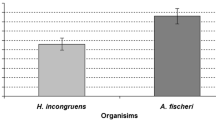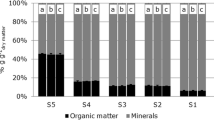Abstract
Purpose
The objectives of the study were to assess the effects of the application of dam reservoir sediment on the properties of sandy soil, the yield of biomass, and the chemical composition of the plants in order to evaluate whether the sediment can be effectively used in agriculture, horticulture, and for land reclamation.
Methods
The air-dry sediment was mixed with soil in the following proportions: 0%:100%, 5%:95%, 25%:75%, 50%:50%, 100%:0%, and a pot experiment was carried out for these components. The test plants contained a grass reclamation mixture. The grass mixture was harvested in three swaths with the total growing season of 120 days. The chemical analysis of the plant material was run to determine the content of macroelements (P, N, S, K, Mg, Ca) and trace elements (Zn, Pb, Cd, Cr, Cu, Ni). The following soil basic chemical properties were assessed at the end of the experiment: pH, sorption capacity, contents of total organic carbon, N, S, available P, K, and trace elements (Zn, Cu, Ni, Pb, Cr, Cd).
Results
As a growing medium component, the tested sediment should be used in a proportion of up to 10% due to its Cd and Zn contents. With its macroelement content, the grass mixture met the requirements for good quality fodder, but due to the high Zn and Cd content, the biomass obtained from it is recommended for industrial use.
Conclusion
The sediments should be used to produce growing medium for non-consumption, environmental, and reclamation purposes.


Similar content being viewed by others
Availability of data and material
Additional data is available on request.
References
Aggelides SM, Londra PA (2000) Effects of compost produced from town wastes and sewage sludge on the physical properties of a loamy and a clay soil. Bioresour Technol 71(3):253–259
Ason B, Ababio FO, Boateng E, Yangyuoru M (2015) Comparative growth response of maize on amended sediment from the Odaw River and cultivated soil. World J Agric Res 3(4):143–147
Baran A, Jasiewicz C, Tarnawski M (2010) Effect of bottom deposit on trace element content in light soil. Ecol Chem Eng A 17(12):1553–1561
Baran A, Tarnawski M, Koniarz T, Jasiewicz C (2016) Agricultural use of sediments from Narożniki reservoir - yield and concentration of macronutrients and trace elements in the plant. Infrastruct Ecol Rural Areas 4:1217–1228
Baran A, Tarnawski M, Urbaniak M (2019) An assessment of bottom sediment as a source of plant nutrients and an agent for improving soil properties. Environ Eng Manag J 18(8):1647–1656
Bartoszek L, Koszelnik P, Gruca-Rokosz R, Kida M (2015) Assessment of agricultural use of the bottom sediments from eutrophic Rzeszów reservoir. Annual Set the Environment Protection 17:396–409
Bortone G, Arevalo E, Deibel I, Detzner H, De Propris L, Elskens F, Giordano A, Hakstege P, Hamer K, Harmsen J, Hauge A, Palumbo L, Van Veen J (2004) Synthesis of the Sednet work package 4 outcomes. J Soil Sediment 4:225–232
Canet R, Chaves C, Pomares F, Albiach R (2003) Agricultural use of sediments from the Albufera Lake (eastern Spain). Agric Ecosyst Environ 95:29–36
Chen B, Liu E, Tian Q, Yan C, Zhang Y (2014) Soil nitrogen dynamics and crop residues: a review. Agron Sustain Dev 34:429–442
Dróżdż D, Malińska K, Kacprzak M et al (2020) Potential of fish pond sediments composts as organic fertilizers. Waste Biomass Valor 11:5151–5163
Ebbs S, Talbott J, Sankaran R (2006) Cultivation of garden vegetables in Peoria Pool sediments from the Illinois River: A case study in trace element accumulation and dietary exposures. Environ Int 32:766–774
EU (European Union) (2015) Commission Decision (EU) 2015/2099 of 18 November 2015 establishing the ecological criteria for the award of the EU ecolabel for growing media, soil improvers and mulch (notified under document C(2015) 7891). European Union, Brussels, Belgium
Fonseca RM, Barriga F, Fyfe WS (1998) Reversing desertification by using dam reservoir sediments as agriculture soils. Episodes 21:218–224
Fuentes A, Llorens M, Saez J, Aguilar MI, Ortuno JF, Meseguer VF (2008) Comparative study of six different sludges by sequential speciation of heavy metals. Bioresour Technol 99:517–525
Hanč A, Tlustoš P, Száková BJ (2006) The changes of cadmium and zinc mobility in sewage sludge after their treatment. Plant Soil Environ 52(2):64–71
Ho Thi Lam T, Nguyen Dinh M, Egashira K (2000) Yield and heavy metal concentration of white cabbage and beet cultivated in soil amended with river sediment from Hanoi, Vietnam. J Fac Agric Kyushu Univ 44:455–462
Jasiewicz C, Baran A, Tarnawski M (2010) Effect of bottom sediment on content, bioaccumulation and translocation of heavy metals in maize biomass. J Elem 15(2):281–291
Jasiewicz C, Madeyski M, Tarnawski M, Baran A (2011) The effect of bottom sediment supplement to soil on yield and chemical composition of maize. Ecol Chem Eng 18(11):1505–1514
Jho EF, Ho Yun S, Jong Lee S, Kim H, Chae H, Kim K (2020) Use of ecotoxicity assessment for determining reusability of treated marine sediment on terrestrial land. J Soils Sediments 20:2306–2315
Kabata-Pendias A, Motowiecka-Terelak T, Piotrowska M, Terelak H, Witek T (1993) Assessment of contamination level of soil and plants with heavy metals and sulphur, IUNG Pulawy Publisher, P(53):1–20 (in Polish)
Kiani M, Raave H, Simojoki A, Tammeorg O, Tammeorg P (2021) Recycling lake sediment to agriculture: effects on plant growth, nutrient availability, and leaching. Sci Total Environ. https://doi.org/10.1016/j.scitotenv.2020.141984
Kim RY, Yoon JK, Kim TS, Yang JE, Owens G, Kim KR (2015) Bioavailability of heavy metals in soils: Definitions and practical implementation—a critical review. Environ Geochem Health, 37(6):1041–1061
Martínez-Nicolas J, Legua P, Núñez-Gómez D, Martínez-Font R, Hernández F, Giordani E, Melgarejo P (2020) Potential of dredged bioremediated marine sediment for strawberry cultivation. Sci Rep 10:19878
Mattei P, Cincinelli A, Martellini T, Natalini R, Pascale E, Renella G (2016) Reclamation of river dredged sediments polluted by PAHs by co-composting with green waste. Sci Total Environ 566–567:567–574
Mattei P, D’Acqui LP, Nicese FP, Lazzerini G, Masciandaro G, Macci C, Doni S, Sarteschi F, Giagnoni L, Renella G (2017) Use of phytoremediated sediments dredged in maritime port as plant nursery growing media. J Environ Manag 186:225–232
Middleton BA, Jiang M (2013) Use of sediment amendments to rehabilitate sinking coastal swamp forests in Louisiana. Ecol Eng 54:183–191
Regulation (2015a) Regulation of the Minister of the Environment of 11 May 2015a on the recovery of waste outside installations and equipment (item 795)
Regulation (2015b) Regulation of the Minister of the Environment of 20 January 2015b on the recovery process R10 method (item 130)
Renella G (2021) Recycling and reuse of sediments in agriculture: where is the problem? Sustainability 13:1648. https://doi.org/10.3390/su13041648
Shi H, Wang X, Xu M, Zhang H, Luo Y (2017) Characteristics of soil C: N ratio and δ13C in wheat-maize cropping system of the North China plain and influences of the Yellow River. Sci Rep 7(1):16854
Szara M, Baran A, Klimkowicz-Pawlas A, Tarnawski M (2020) Ecotoxicological and chemical properties of the Rożnów reservoir bottom sediment amended with various waste materials. J Environ Manage 273:111176. https://doi.org/10.1016/j.jenvman.2020.111176
Talgre L, Roostalu H, Mäeorg E, Lauringson E (2017) Nitrogen and carbon release during decomposition of roots and shoots of leguminous green manure crops. Agron Res 15(2): 594–601
Tarnawski M, Baran A, Koniarz T (2015) The effect of bottom sediment supplement on changes of soil properties and on the chemical composition of plants. Geology Geophysics Environment 41:285–292
Tozzi F, Pecchioli S, Renella G, Pablo R, Legua P, Macci C, Doni S, Masciandaro G, Giordani E, Lenzi A (2019) Remediated marine sediment as growing medium for lettuce production: assessment of agronomic performance and food safety in a pilot experiment. J Sci Food Agric. https://doi.org/10.1002/jsfa.9815
Twinch AJ, Breen CM (1982) Vertical stratification in sediments from a young oligotrophic South African impoundment: Implications in phosphorus cycling. Hydrobiologia 92:395–404
Urbaniak M, Baran A, Lee S, Kannan K (2020) Utilization of PCB-contaminated Hudson River sediment by thermal processing and phytoremediation. Sci Total Environ 738:139841
Urbaniak M, Baran A, Szara M, Mierzejewska E, Lee S, Takazawa M, Kannan K (2019) Evaluation of ecotoxicological and chemical properties of soil amended with Hudson river (New York, USA) sediment. Environ Sci Pollut Res 27:7388–7397
van Driel W, van Luit B, Smilde KW, Schuurmans W (1995) Heavy metal uptake by crops from polluted river sediments covered by non-polluted topsoil. I. Effects of topsoil depth on metal contents. Plant Soil 175:93–104
Walter K, Gunkel G, Gamboa N (2012) An assessment of sediment reuse for sediment management of Gallito Ciego Reservoir, Peru. Lakes Reserv Res Manag 17:301–314
Wiśniowska-Kielan B, Arasimowicz M, Niemiec M (2012) Post-effect of bottom sediment addition to the substratum on chemical composition of white mustard (Sinapis alba L.) biomass. Part 2. Quantitative ratios between macroelements. Eco Chem Eng A 19(4–5):387–393
Wiśniowska-Kielian B, Niemiec M (2007) Effect of bottom sediment addition to the substratum on the quality of produced maize biomass. Ecol Chem Eng 14(5–6):581–589
Zawisza E, Michalec B, Gruchot A et al (2015) Technical conditions for the revitalization of the Chechło water reservoir in the Trzebinia commune. University of Krakow, Poland 183 p (polish)
Funding
The study was financed by the University of Agriculture in Krakow through the financial support of the Polish Ministry of Education and Science.
Author information
Authors and Affiliations
Contributions
Tomasz Koniarz: Investigation; conceptualization; writing, original draft; visualization, Agnieszka Baran: Investigation, conceptualization, methodology, formal analysis, writing – review and editing, Marek Tarnawski: Resources; visualization; writing, review and editing; funding acquisition.
Corresponding author
Ethics declarations
Ethics approval
Not applicable.
Consent to participate
Informed consent was obtained from all individual participants included in the study.
Consent for publication
Not applicable.
Competing interests
The authors declare no competing interests.
Additional information
Responsible editor: Jos Brils
Publisher's Note
Springer Nature remains neutral with regard to jurisdictional claims in published maps and institutional affiliations.
Rights and permissions
About this article
Cite this article
Koniarz, T., Baran, A. & Tarnawski, M. Agronomic and environmental quality assessment of growing media based on bottom sediment. J Soils Sediments 22, 1355–1367 (2022). https://doi.org/10.1007/s11368-022-03173-4
Received:
Accepted:
Published:
Issue Date:
DOI: https://doi.org/10.1007/s11368-022-03173-4




